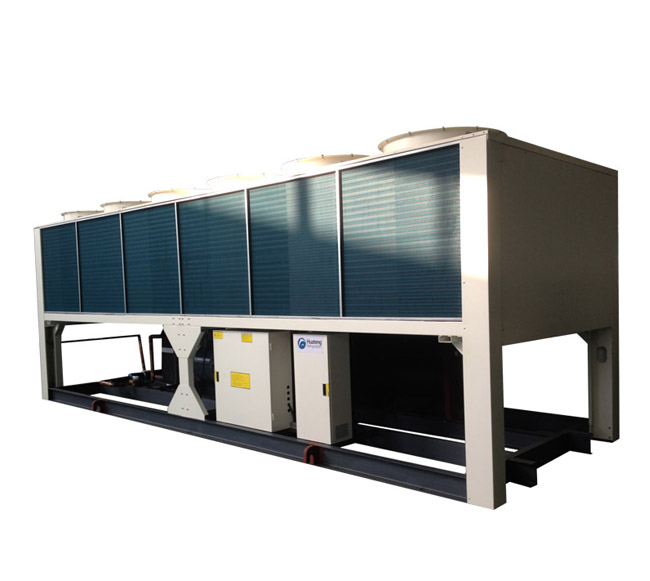- Home
- Products
- About Us
- News
- Project
- Video
- Soliutions/Oem/Custom
- Contact Us
Chiller costs consume a substantial part of your building’s utility bills. What measures should one take to obtain energy savings through maximal efficiency of the chiller system? Let’s examine some possibilities.
Two different cooling mediums (air or water) can facilitate the transfer of the latent heat given up as the refrigerant changes from vapor to liquid. Thus, chillers can use two different types of condensers, air-cooled and water-cooled.
Air-cooled condensers resemble the “radiators” that cool automobile engines. They use a motorized blower to force air across a grid of refrigerant lines. Unless they are specially designed for high-ambient conditions, air-cooled condensers require ambient temperatures of 95°F (35°C) or below to operate effectively.
Water-cooled condensers perform the same function as air-cooled condensers, but require two steps to complete the heat transfer. First, heat moves from refrigerant vapor into the condenser water. Then, the warm condenser water is pumped to a cooling tower where the process heat is ultimately discharged to the atmosphere.
Water-cooled chillers feature a water-cooled condenser connected with a cooling tower. They have commonly been used for medium and large installations that have a sufficient water supply. Water-cooled chillers can produce more constant performance for commercial and industrial air conditioning because of the relative independence to fluctuations of the ambient temperature. Water-cooled chillers range in size from small 20-ton capacity models to several thousand-ton models that cool the world’s largest facilities such as airports, shopping malls and other facilities.
A typical water-cooled chiller uses recirculating condenser water from a cooling tower to condense the refrigerant. A water-cooled chiller contains a refrigerant dependent on the entering condenser water temperature (and flow rate), which functions in relation to the ambient wet-bulb temperature. Since the wet-bulb temperature is always lower than the dry-bulb temperature, the refrigerant condensing temperature (and pressure) in a water-cooled chiller can often operate significantly lower than an air-cooled chiller. Thus, water-cooled chillers can operate more efficiently.
Water-cooled chillers typically reside indoors in an environment protected from the elements. Hence, water-cooled chiller can offer a longer lifespan. Water-cooled chillers typically represent the only option for larger installations. The additional cooling tower system will require additional installation expense and maintenance as compared to air-cooled chillers.

Air-cooled chillers rely on a condenser cooled by the environment air. Thus, air-cooled chillers may find common application in smaller or medium installations where space constraints may exist. An air-cooled chiller can represent the most practical choice in scenarios where water represents a scarce resource.
A typical air-cooled chiller can feature propeller fans or mechanical refrigeration cycles to draw ambient air over a finned coil to condense the refrigerant. The condensation of the refrigerant vapor in the air-cooled condenser enables the transfer of heat to the atmosphere.
Air-cooled chillers offer the significant advantage of lower installation costs. Simpler maintenance also results due to their relative simplicity as compared to water-cooled chillers. Air-cooled chillers will occupy less space, but will mostly reside outside a facility. Thus, the outdoor elements will compromise their functional lifespan.
The all-inclusive nature of air-cooled chillers reduces maintenance costs. Their relative simplicity coupled with reduced space requirements produces great advantages in many types of installations.
Chiller systems will operate more efficiently through proper ongoing maintenance. Most organizations recognize this value and have taken steps as part of their day-to-day facility management best practices. Some common best practices for chiller systems include:
Heat transfer has a large effect on chiller systems and remains fundamental to producing efficient chiller operation. Routine maintenance should inspect condenser coils for clogging and free air passage.
A chiller’s cooling quotient depends on proper refrigerant levels in the system. Maintaining proper refrigerant charge can greatly impact energy efficiency by reducing cooling costs by nearly 5-10%.
Condenser water loops used with cooling towers must maintain proper water flow as designed. Any debris like sand, erosive solids and contamination materials can affect the condenser water loop. Fouling or scaling can inhibit water flow and greatly impact the chiller operating efficiency.
Copyright © Water Cooled Chiller, Water Cooled Scroll Chiller Supplier China All Rights Reserved | Sitemap